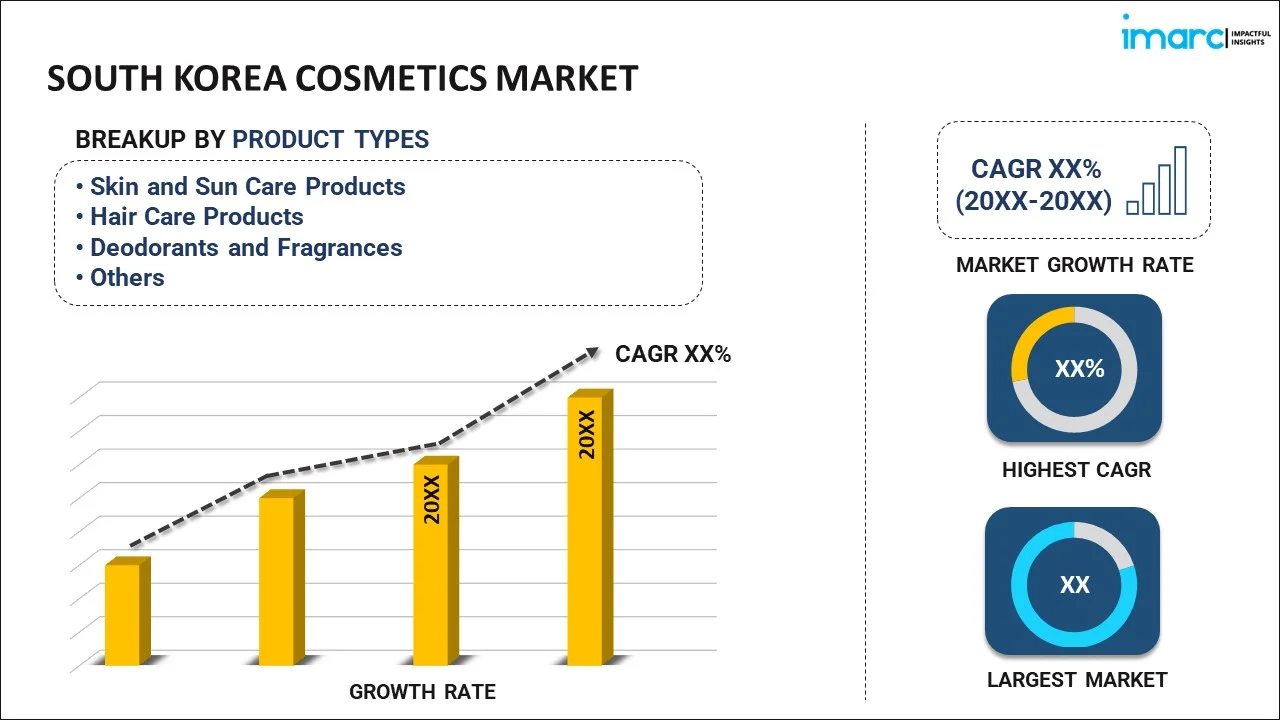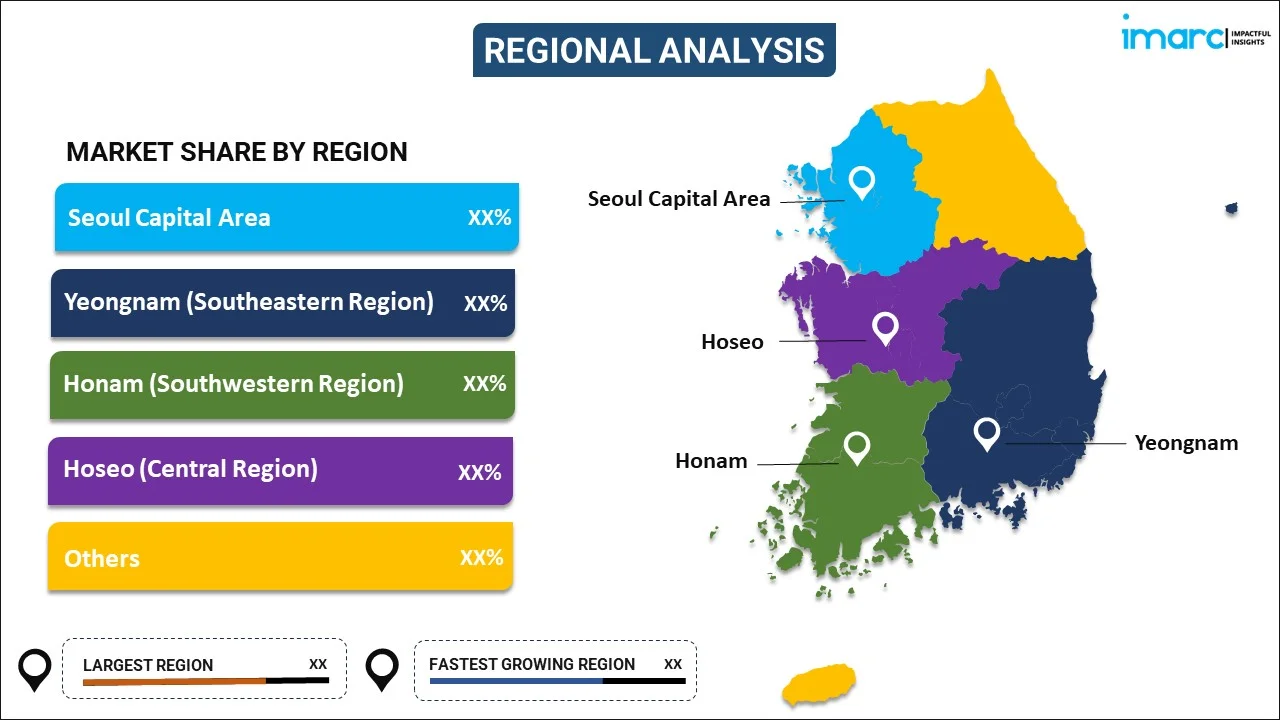
South Korea Cosmetics Market Report by Product Type (Skin and Sun Care Products, Hair Care Products, Deodorants and Fragrances, Makeup and Color Cosmetics, and Others), Category (Conventional, Organic), Gender (Men, Women, Unisex), Distribution Channel (Supermarkets and Hypermarkets, Specialty Stores, Pharmacies, Online Stores, and Others), and Region 2025-2033
Market Overview:
South Korea cosmetics market size is projected to exhibit a growth rate (CAGR) of 5.50% during 2025-2033. The growing influence of social media platforms, along with the widespread adoption of extensive skincare routine by individuals, is primarily driving the market growth across the country.
|
Report Attribute
|
Key Statistics
|
|---|---|
|
Base Year
|
2024 |
|
Forecast Years
|
2025-2033
|
|
Historical Years
|
2019-2024
|
| Market Growth Rate (2025-2033) | 5.50% |
Cosmetics encompass a diverse range of items utilized for personal care, grooming, and the enhancement of one's visual appeal. Tailored for application on the body, face, hair, nails, or lips, these products aim to refine or modify individual aesthetic features. They are commonly available in various formulations like creams, lotions, powders, gels, serums, and sprays, catering to both men and women for various purposes. In line with this, the scope of cosmetics extends to an extensive array of skincare products, including cleansers, moisturizers, serums, toners, masks, and anti-aging treatments. Their formulations are crafted to purify, hydrate, nourish, shield, and enhance the overall health and appearance of the skin.
South Korea Cosmetics Market Trends:
The South Korea cosmetics market has experienced a remarkable surge, propelled by distinct drivers and evolving trends. The "K-beauty," has gained international acclaim, fostering the escalating demand for Korean skincare and makeup products, thereby the market growth across the country. Additionally, technological innovation plays a pivotal role, with South Korea being a hub for cutting-edge beauty research and development, which is acting as another significant growth-inducing factor. Besides this, the fusion of traditional ingredients with modern science has given rise to unique formulations, contributing to the industry's growth. Social media's influence has been a significant driver, with K-beauty product trends spreading rapidly through platforms like Instagram and YouTube. Moreover, the emphasis on natural ingredients, cruelty-free products, and eco-friendly packaging aligns with the increasing need for sustainable and ethical beauty practices, thereby positively influencing the regional market. Furthermore, South Korea's advanced retail landscape, marked by innovative in-store experiences and e-commerce dominance, has facilitated widespread accessibility. Apart from this, with a keen focus on customization, South Korean cosmetics cater to diverse skin tones and concerns, reflecting an inclusive approach. This, in turn, is expected to fuel the regional market over the forecasted period.
South Korea Cosmetics Market Segmentation:
IMARC Group provides an analysis of the key trends in each segment of the market, along with forecasts at the country level for 2025-2033. Our report has categorized the market based on product type, category, gender, and distribution channel.
Product Type Insights:

- Skin and Sun Care Products
- Hair Care Products
- Deodorants and Fragrances
- Makeup and Color Cosmetics
- Others
The report has provided a detailed breakup and analysis of the market based on the product type. This includes skin and sun care products, hair care products, deodorants and fragrances, makeup and color cosmetics, and others.
Category Insights:
- Conventional
- Organic
A detailed breakup and analysis of the market based on the category have also been provided in the report. This includes conventional and organic.
Gender Insights:
- Men
- Women
- Unisex
The report has provided a detailed breakup and analysis of the market based on the gender. This includes men, women, and unisex.
Distribution Channel Insights:
- Supermarkets and Hypermarkets
- Specialty Stores
- Pharmacies
- Online Stores
- Others
A detailed breakup and analysis of the market based on the distribution channel have also been provided in the report. This includes supermarkets and hypermarkets, specialty stores, pharmacies, online stores, and others.
Regional Insights:

- Seoul Capital Area
- Yeongnam (Southeastern Region)
- Honam (Southwestern Region)
- Hoseo (Central Region)
- Others
The report has also provided a comprehensive analysis of all the major regional markets, which include Seoul Capital Area, Yeongnam (Southeastern Region), Honam (Southwestern Region), Hoseo (Central Region), and Others.
Competitive Landscape:
The market research report has also provided a comprehensive analysis of the competitive landscape in the market. Competitive analysis such as market structure, key player positioning, top winning strategies, competitive dashboard, and company evaluation quadrant has been covered in the report. Also, detailed profiles of all major companies have been provided. Some of the key players include:
- Amorepacific Corporation
- Banila Co.
- CLUBCLIO Co. Ltd.
- Dr. Jart+
- L'Oréal S.A.
- PFD Co. Ltd.
- S&P Cosmetic Co. Ltd.
- The Face Shop (LG Household & Health Care)
- Unilever Plc
(Please note that this is only a partial list of the key players, and the complete list is provided in the report.)
South Korea Cosmetics Market Report Coverage:
| Report Features | Details |
|---|---|
| Base Year of the Analysis | 2024 |
| Historical Period | 2019-2024 |
| Forecast Period | 2025-2033 |
| Units | Billion US$ |
| Scope of the Report | Exploration of Historical and Forecast Trends, Industry Catalysts and Challenges, Segment-Wise Historical and Predictive Market Assessment:
|
| Product Types Covered | Skin and Sun Care Products, Hair Care Products, Deodorants and Fragrances, Makeup and Color Cosmetics, Others |
| Categories Covered | Conventional, Organic |
| Genders Covered | Men, Women, Unisex |
| Distribution Channels Covered | Supermarkets and Hypermarkets, Specialty Stores, Pharmacies, Online Stores, Others |
| Regions Covered | Seoul Capital Area, Yeongnam (Southeastern Region), Honam (Southwestern Region), Hoseo (Central Region), Others |
| Companies Covered | Amorepacific Corporation, Banila Co., CLUBCLIO Co. Ltd., Dr. Jart+, L'Oréal S.A., PFD Co. Ltd., S&P Cosmetic Co. Ltd., The Face Shop (LG Household & Health Care), Unilever Plc, etc. (Please note that this is only a partial list of the key players, and the complete list is provided in the report.) |
| Customization Scope | 10% Free Customization |
| Report Price and Purchase Option | Single User License: US$ 3699 Five User License: US$ 4699 Corporate License: US$ 5699 |
| Post-Sale Analyst Support | 10-12 Weeks |
| Delivery Format | PDF and Excel through Email (We can also provide the editable version of the report in PPT/Word format on special request) |
Key Questions Answered in This Report:
- How has the South Korea cosmetics market performed so far and how will it perform in the coming years?
- What has been the impact of COVID-19 on the South Korea cosmetics market?
- What is the breakup of the South Korea cosmetics market on the basis of product type?
- What is the breakup of the South Korea cosmetics market on the basis of category?
- What is the breakup of the South Korea cosmetics market on the basis of gender?
- What is the breakup of the South Korea cosmetics market on the basis of distribution channel?
- What are the various stages in the value chain of the South Korea cosmetics market?
- What are the key driving factors and challenges in the South Korea cosmetics?
- What is the structure of the South Korea cosmetics market and who are the key players?
- What is the degree of competition in the South Korea cosmetics market?
Key Benefits for Stakeholders:
- IMARC’s industry report offers a comprehensive quantitative analysis of various market segments, historical and current market trends, market forecasts, and dynamics of the South Korea cosmetics market from 2019-2033.
- The research report provides the latest information on the market drivers, challenges, and opportunities in the South Korea cosmetics market.
- Porter's five forces analysis assist stakeholders in assessing the impact of new entrants, competitive rivalry, supplier power, buyer power, and the threat of substitution. It helps stakeholders to analyze the level of competition within the South Korea cosmetics industry and its attractiveness.
- Competitive landscape allows stakeholders to understand their competitive environment and provides an insight into the current positions of key players in the market.
Need more help?
- Speak to our experienced analysts for insights on the current market scenarios.
- Include additional segments and countries to customize the report as per your requirement.
- Gain an unparalleled competitive advantage in your domain by understanding how to utilize the report and positively impacting your operations and revenue.
- For further assistance, please connect with our analysts.
 Inquire Before Buying
Inquire Before Buying
 Speak to an Analyst
Speak to an Analyst
 Request Brochure
Request Brochure
 Request Customization
Request Customization




.webp)




.webp)












